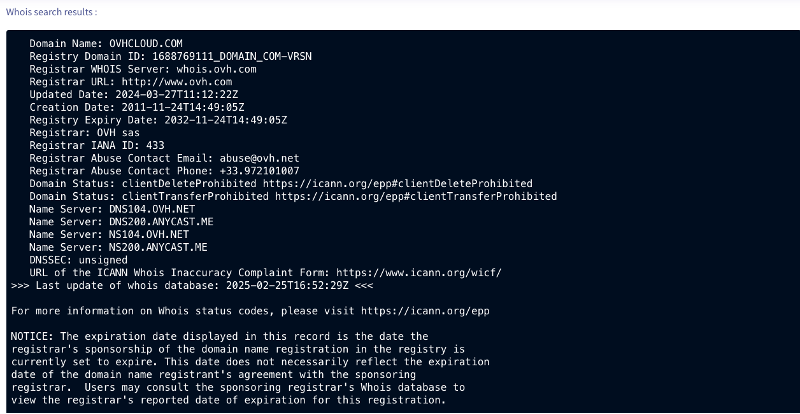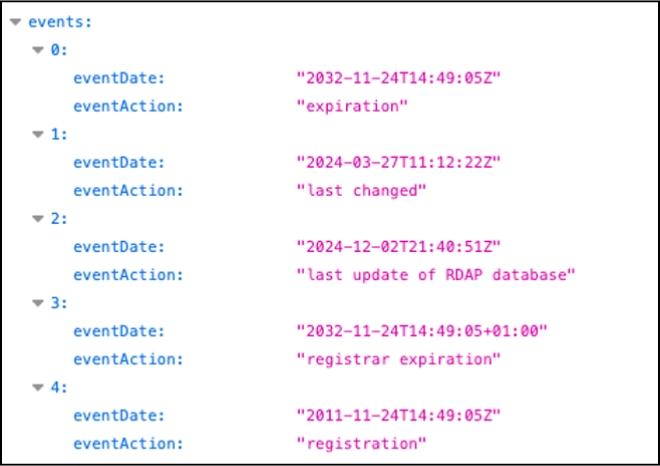WHOIS vs RDAP
WHOIS vs RDAP: the differences
WHOIS and RDAP are two protocols that can be used to identify domain name owners on the internet. While WHOIS largely displays personal data, RDAP is based on a modern protocol designed for current web usage, and offers a more secure and granular management of information access.

What is WHOIS?
A long-standing online identification tool
WHOIS is a service that has existed since the Internet was first created. Set up in the 1980s, it was designed as a query system for publicly viewing information associated with a domain name or IP address. Its role was to provide transparency on domain registration, easily identify domain owners, and even to help retrieve an expired or abandoned domain name.
When a web user or professional performs a WHOIS search, they can access information such as:
- the domain registrar
- the domain creation date and expiry date
- the contact details of the owner, or of the administrative/technical contact
- the associated IP address (in the case of WHOIS IP)
This has long been considered a standard for managing online identities, particularly when it comes to combating internet fraud and malicious use. In just a few clicks, any user can access a domain name’s data, making it easier to monitor and verify information in a growing web space.
The limitations of WHOIS
As digital practices have evolved over time, several problems have arisen in the use of WHOIS.
- Exposure of personal data: all information on domain owners (name, address, phone number, email) was publicly accessible. This has posed significant privacy issues, particularly with the introduction of the GDPR (General Data Protection Regulation) in Europe.
- Potential for misuse: WHOIS databases have become a valuable source for spammers, cyberbullies and even unscrupulous companies, exploiting this data for unsolicited sales pitches.
- Lack of technical standardisation: The information provided by WHOIS is sent as plain text, making it difficult for software or analytics systems to interpret it automatically. This greatly limits the possibilities for technical integration or automation.
- Mishandling international character sets: Whois does not properly support non-Latin characters, which can cause problems for users in certain countries, or for domain names in Cyrillic, Arabic, or Asian alphabets.
In light of these limitations, our needs have evolved into a more secure, structured protocol that is better adapted to our confidentiality, legal compliance and web technology requirements. Thus RDAP was born.
What is RDAP?
A modern protocol to replace WHOIS
The RDAP (Registration Data Access Protocol) is the new protocol for consulting information on domain names, designed to gradually replace WHOIS. It was set up at the instigation of ICANN (Internet Corporation for Assigned Names and Numbers) with the aim of overcoming the technical and legal limitations of the previous system.
While WHOIS relied on open, unfiltered access to personal data, RDAP introduces a more secure, standardised approach, customised to the user’s profile. This more granular management system meets the new standards for privacy protection, interoperability and technical integration.
Stronger protection for personal data
One of the key advantages of RDAP is how it publishes information in a different way. Specifically, this means that the contact details of a domain name registrant are not publicly displayed by default. Access to certain sensitive information may be restricted or hidden depending on:
- the identity and rights of the user making the request (individual, authority, registrar, etc.);
- the confidentiality policy set up by the registry or registrar;
- the type of data requested (technical, administrative, legal, etc.).
This feature allows for more refined protection of domain owner identity, while retaining secure access to useful information in the event of misuse or legal disputes.
A structured and interoperable protocol
RDAP uses the JavaScript Object Notation (JSON) format to transmit domain name information. Unlike WHOIS, which provides plain text responses that are difficult to work with, JSON offers a machine-readable structure that can automatically integrate into management, analysis, or monitoring tools. This standardised format also ensures a uniform interpretation of the data, whichever registry is queried. This technical breakthrough is a major advantage for customers, service providers and web professionals, who can now harness domain information more reliably and accurately.
Better internationalisation of domain names
RDAP fully supports non-Latin characters, making it an inclusive and universal protocol. It allows you to correctly search for and display information from domain names written in any alphabet (Cyrillic, Chinese, Arabic, etc.). This facilitates:
- global domain management
- multilingual identity searches
- interoperability between global name registration services
Towards a smarter way to search
RDAP also provides advanced features that WHOIS lacks. This includes the ability to perform accurate searches on specific types of technical information, access multiple related records simultaneously (such as sub-domains or network objects), and optimise request processing through paging, filtering, and authentication mechanisms. These capabilities increase its efficiency, while ensuring better protection of personal data and a response more adapted to the current requirements of the internet and its users.
WHOIS vs RDAP: the differences at a glance
The WHOIS and RDAP protocols have similar objectives, but run in very different ways. To better understand, here is a summary table of their main differences:
| Criteria | WHOIS | RDAP |
| Response format | Plain, unstructured text | Structured and usable JSON format |
| Data protection | Personal data accessible to all | Access limited depending on profile and permissions |
| Interoperability | Low, non-standardised | Strong, meets modern standards |
| Internationalisation | Latin characters only | Comprehensive support for non-Latin alphabets |
| Advanced searches | Not possible | Ability to filter, page, and access network objects |
| User readability | Manual Read Only | Usable by online applications and services |
| ICANN/GDPR compliance | Partial | Designed to comply with international privacy policies |
Visual comparison of WHOIS and RDAP responses
WHOIS query results
The WHOIS display is raw, unstructured, and displays all the domain information together, including the owner’s personal data (such as the abuse contact, DNS servers, and creation date). This type of response is readable to the naked eye, but not technically feasible for automated services. What’s more, no identity or user protection is dynamically applied.


RDAP query results
The RDAP output comes in a JSON format, structured as key-value pairs, which facilitates automated analysis. Each event (creation, expiry, update, etc.) is clearly time-stamped and identified. Sensitive information may be hidden depending on the registry policy or the user’s access rights. This format integrates well into security tools, domain management tools or web solutions.
Why OVHcloud is embracing RDAP and how to take it further
At OVHcloud, access to domain data is based on both the WHOIS protocol, still used for most national extensions (ccTLDs), and the RDAP protocol, now in place for generic extensions (gTLDs) such as .com, .tech and .app. This development is part of ICANN’s approach to align with current technical standards in terms of security, data structure and compliance with regulations such as the GDPR.
This dual support allows OVHcloud to meet the different requirements of registries, while ensuring that users get reliable and secure access to domain information.
Our most popular domain extensions
Finding a suitable domain name is a key step in building your website. That’s why OVHcloud offers a wide selection of extensions, adapted to different profiles and objectives. Here are three options that are particularly popular with our users:
Your questions answered
Is RDAP already used by all registrars?
No, the decision to adopt RDAP depends on the policies of each registry or registrar. Some have already switched over entirely, while others still maintain compatibility with WHOIS.
Will I need to change the way I query a domain?
Not necessarily. For end users, web interfaces offered by hosting providers (such as OVHcloud) will continue to offer a simple, intuitive experience, regardless of the underlying technology. The changes are mainly at a more technical level for developers or applications exploiting domain data.
Can I access all the information on a domain with RDAP?
No, the RDAP applies different levels of access rules. Some personal information, such as the owner’s email address or phone number, may be hidden if you do not have the necessary permissions. This aims to protect digital identities while maintaining a sufficient level of transparency for competent authorities.
Will WHOIS disappear completely?
WHOIS is being phased out, but it has not yet disappeared. It still coexists with RDAP in many cases. However, most registries should adopt the RDAP as their reference system in the medium term, as it is more in line with confidentiality requirements and modern standards.
Where can I test an RDAP request?
You can perform RDAP tests directly on platforms such as rdap.ovh.com. This type of interface allows you to view structured results, understand how the protocol works, and compare it with traditional WHOIS. It’s a great way to explore the real benefits of the system for your domain searches.